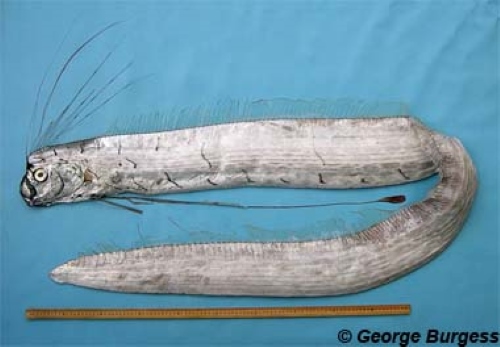Recent sightings of the rare Oarfish near Baja California Sur, Mexico, referred to as the 'Doomsday Fish.' This deep-sea creature is believed to be a harbinger of natural disasters, particularly earthquakes and tsunamis. While folklore strengthens this belief, scientific research remains inconclusive on whether a direct correlation exists between oarfish sightings and seismic activity. Oarfish (Regalecus glesne) are among the most fascinating and mysterious deep-sea creatures. Their enormous size, unique appearance, and rare sightings have contributed to various myths and legends.
https://www.instagram.com/reel/DGUARFjqbWA/?utm_source=ig_web_copy_link
What is Oarfish?

Source:George Burgess
Oarfish are rarely seen by humans due to their deep-sea habitat. They are considered one of the longest bony fish, with their ribbon-like bodies helping them float seamlessly through the water column. Below is an overview of their key characteristics:
Oarfish Overview
| Feature | Description |
| Scientific Name | Regalecus glesne |
| Common Name | Oarfish, Doomsday Fish |
| Size | Up to 30+ feet (9 meters) |
| Habitat | Deep sea (mesopelagic zone, up to 1,000 meters deep) |
| Diet | Krill, plankton, and small crustaceans |
| Appearance | Long, silvery body with red crown-like spines |
Why Are They Called "Doomsday Fish"?
The eerie nickname "Doomsday Fish" stems from various cultural legends associating oarfish sightings with impending natural disasters.
Reasons Behind the Myth
- Earthquake Connection: In Japan and the Philippines, oarfish are considered omens of earthquakes and tsunamis. Before the 2011 Japan earthquake, 20 oarfish were reportedly washed ashore, fuelling this belief.
- Rare Surface Sightings: Since oarfish live in deep-sea environments, their presence near the surface is unusual and often linked to sickness or disorientation. This rarity has contributed to superstitions.
- Ancient Legends: Oarfish, due to their size and odd shape, may have inspired ancient sea monster myths. Their undulating swimming motion adds to their mysterious aura.
Biological Features and Adaptations
Oarfish possess several adaptations that allow them to survive in deep waters:
- Silvery, reflective body: Acts as camouflage in deep-sea environments.
- Large Eyes: Aid in detecting faint light in dark waters.
- Vertical Floating: They are often seen floating vertically, which helps them blend with the water column.
- Filter Feeding: Oarfish primarily consume small marine organisms such as krill and plankton.
Conservation Concerns
Despite being rarely studied, oarfish and other deep-sea creatures face growing environmental threats.
Major Threats
- Plastic Pollution: Marine debris and microplastics are increasingly affecting deep-sea ecosystems.
- Climate Change: Rising ocean temperatures may disrupt deep-sea habitats.
- Deep-Sea Exploration & Fishing: Increased human activities in deeper ocean zones pose unknown risks to oarfish populations.
What Can Be Done?
- Reduce Plastic Waste: Implementing source-reduction policies can significantly reduce ocean pollution.
- Support Marine Conservation: Organizations like Ocean Conservancy advocate for protecting deep-sea species and ecosystems.
- Promote Scientific Research: Further studies on oarfish behavior and habitat will improve conservation efforts.
What is the mythological significance behind this oarfish?
Recently, this rare oarfish near Baja California Sur, Mexico, has been spotted and has various mythological significance behind it. Japanese folklore dating back to the 17th century suggests that the appearance of the oarfish near shore foretells impending disasters. This belief gained traction in 2011 when several oarfish were found on Japanese beaches months before the devastating Tōhoku earthquake and tsunami.
| Japanese Name | Meaning |
| Ryugu no Tsukai | "Sea God’s Palace Messenger" |
Historical Incidents Supporting the Myth
| Year | Location | Event |
| 2011 | Japan | Tōhoku earthquake and tsunami |
| 2017 | Philippines | A 6.6 magnitude earthquake followed an oarfish sighting |
| 2013 | California, USA | Oarfish washed ashore but no disaster followed |
Despite these instances, scientists argue that these events could be coincidental rather than an established pattern.
Scientific Perspectives: What Research Says
While folklore links oarfish to natural disasters, scientific explanations provide a different viewpoint:
Leading Theories
- Seismic Sensitivity Hypothesis: Some scientists suggest that deep-sea fish like the oarfish are susceptible to seismic activity due to their habitat near fault lines, making them more likely to surface before an earthquake.
- Environmental Factors: Other researchers argue that strong ocean currents, temperature changes, or illness may drive oarfish to shallow waters rather than seismic activity.
- Scientific Findings: A 2019 study published in the Bulletin of the Seismological Society of America found no significant correlation between oarfish sightings and earthquakes in Japan.
Recent Surge in Deep-Sea Creature Sightings
Apart from the oarfish, other deep-sea creatures like anglerfish have recently been appearing in unexpected locations, raising concerns over changing ocean conditions.
Notable Sightings in 2025
| Date | Species | Location |
| February | Black Seadevil Anglerfish | Tenerife, Spain |
| February | Oarfish | Playa Quemada, Lanzarote |
| February | Oarfish | Baja California, Mexico |
Possible Explanations for Unusual Marine Behavior
Scientists have proposed several environmental explanations for the unusual behavior of deep-sea creatures:
Key Environmental Factors
- Climate Change & Warming Oceans:
- Rising ocean temperatures affect deep-sea ecosystems, leading to migration towards shallower waters.
- The ocean absorbs 90% of excess heat from global warming, disrupting marine habitats.
- Underwater Seismic Activity:
- Seismic shifts can release gas bubbles and electrostatic charges, potentially disturbing deep-sea organisms.
- El Niño & La Niña Effects:
- These climate cycles alter ocean currents, affecting marine life distribution.
- Natural Life Cycle Events:
- Some researchers argue that deep-sea strandings have always occurred but are now more visible due to modern technology and social media.
Conclusion
While oarfish remain an enigma of the deep sea, their rarity and unique features have led to enduring myths. Whether or not they truly predict disasters, their existence highlights the need to protect our oceans. By reducing plastic waste and supporting conservation initiatives, we can ensure that deep-sea species like oarfish continue to thrive in their mysterious underwater world.
Comments
All Comments (0)
Join the conversation